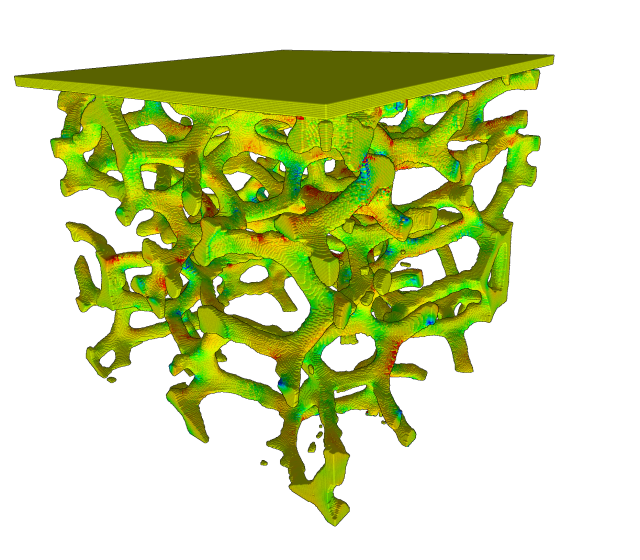 Uintah has been used by collaborators at Los Alamos National Laboratory to model the dynamic compaction of foams, such as those used to isolate nuclear weapons components from shock loading. The Material Point Method component was used to carry out these simulations, which allowed for compression of the foam to full densification. This is noteworthy for several reasons. First, the geometry of the samples was collected using micro-CT. As in the angiogenesis project described above, because MPM is a particle method, conversion of the image data to an appropriate computational geometry is fast and straightforward, especially in comparison to methods using a body fitted mesh. Second, the degree of compression achieved far exceeds that which can be reached by other methods due to MPM's ability to handle large deformation and contact. Finally, this type of direct numerical simulation allows users to correlate microscopic behavior of the foam constituent material with the bulk behavior. Even without considering interstitial fluid, these computations represent a large step forward. But, owing to our fluid-structure interaction capability, future work will allow inclusion of air or other fluid, an important consideration especially in high-rate loading situations. Material Point Method simulation of compaction of a 1 mm cubed sample of reticulated foam. Initial geometry was collected via micro-CT with each voxel in the 3D image chosen to represent either the parent material or void, depending on the image intensity. Individual particles are colored by equivalent stress.
Uintah has been used by collaborators at Los Alamos National Laboratory to model the dynamic compaction of foams, such as those used to isolate nuclear weapons components from shock loading. The Material Point Method component was used to carry out these simulations, which allowed for compression of the foam to full densification. This is noteworthy for several reasons. First, the geometry of the samples was collected using micro-CT. As in the angiogenesis project described above, because MPM is a particle method, conversion of the image data to an appropriate computational geometry is fast and straightforward, especially in comparison to methods using a body fitted mesh. Second, the degree of compression achieved far exceeds that which can be reached by other methods due to MPM's ability to handle large deformation and contact. Finally, this type of direct numerical simulation allows users to correlate microscopic behavior of the foam constituent material with the bulk behavior. Even without considering interstitial fluid, these computations represent a large step forward. But, owing to our fluid-structure interaction capability, future work will allow inclusion of air or other fluid, an important consideration especially in high-rate loading situations. Material Point Method simulation of compaction of a 1 mm cubed sample of reticulated foam. Initial geometry was collected via micro-CT with each voxel in the 3D image chosen to represent either the parent material or void, depending on the image intensity. Individual particles are colored by equivalent stress.Simulation of Foam Compression - DOE
 Uintah has been used by collaborators at Los Alamos National Laboratory to model the dynamic compaction of foams, such as those used to isolate nuclear weapons components from shock loading. The Material Point Method component was used to carry out these simulations, which allowed for compression of the foam to full densification. This is noteworthy for several reasons. First, the geometry of the samples was collected using micro-CT. As in the angiogenesis project described above, because MPM is a particle method, conversion of the image data to an appropriate computational geometry is fast and straightforward, especially in comparison to methods using a body fitted mesh. Second, the degree of compression achieved far exceeds that which can be reached by other methods due to MPM's ability to handle large deformation and contact. Finally, this type of direct numerical simulation allows users to correlate microscopic behavior of the foam constituent material with the bulk behavior. Even without considering interstitial fluid, these computations represent a large step forward. But, owing to our fluid-structure interaction capability, future work will allow inclusion of air or other fluid, an important consideration especially in high-rate loading situations. Material Point Method simulation of compaction of a 1 mm cubed sample of reticulated foam. Initial geometry was collected via micro-CT with each voxel in the 3D image chosen to represent either the parent material or void, depending on the image intensity. Individual particles are colored by equivalent stress.
Uintah has been used by collaborators at Los Alamos National Laboratory to model the dynamic compaction of foams, such as those used to isolate nuclear weapons components from shock loading. The Material Point Method component was used to carry out these simulations, which allowed for compression of the foam to full densification. This is noteworthy for several reasons. First, the geometry of the samples was collected using micro-CT. As in the angiogenesis project described above, because MPM is a particle method, conversion of the image data to an appropriate computational geometry is fast and straightforward, especially in comparison to methods using a body fitted mesh. Second, the degree of compression achieved far exceeds that which can be reached by other methods due to MPM's ability to handle large deformation and contact. Finally, this type of direct numerical simulation allows users to correlate microscopic behavior of the foam constituent material with the bulk behavior. Even without considering interstitial fluid, these computations represent a large step forward. But, owing to our fluid-structure interaction capability, future work will allow inclusion of air or other fluid, an important consideration especially in high-rate loading situations. Material Point Method simulation of compaction of a 1 mm cubed sample of reticulated foam. Initial geometry was collected via micro-CT with each voxel in the 3D image chosen to represent either the parent material or void, depending on the image intensity. Individual particles are colored by equivalent stress.